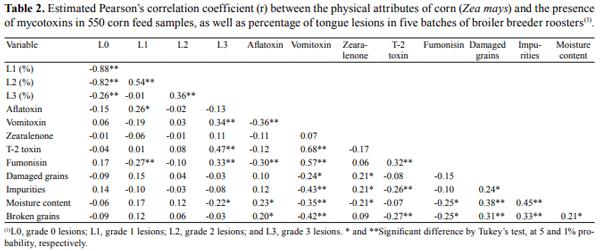Mycotoxins are toxic secondary metabolites produced by fungi and are involved in the contamination of grains used in human and animal diets (Gimeno, 2012). When ingested in high amounts, mycotoxins can affect the health and performance of animals by decreasing their immune response and increasing their mortality rates (Murugesan et al., 2015).
The most important mycotoxicoses in breeder chickens are caused by aflatoxin B1, ochratoxin A, T-2 toxin, and diacetoxyscirpenol (DAS), and fewer cases of poisoning are caused by vomitoxin and deoxynivalenol (DON). Adult birds are less resistant to zearalenone and fumonisin B1 (Gimeno, 2012).
Corn (Zea mays L.), which is the primary product used in bird feed production, may be contaminated with different mycotoxins (Savi et al., 2016; Wu et al., 2016). The quality of this cereal is affected by the physical attributes and primary structural defects of its grains, including cracks, foreign matter, impurities, and breakages, caused by mechanical damage during harvest and storage. These physical defects may facilitate fungal colonization and mycotoxin contamination in the grains (Brasil, 2011).
When laying chickens consume food products contaminated with mycotoxins, there may be inflammation and necrosis in the oral cavity. The performance of birds with oral lesions is impaired because of immune dysfunction, reduced feed intake, and lower daily weight gain (Diaz et al., 2016). Brake et al. (2000) evaluated the effect of trichothecenes in the diet of breeder chickens and observed that DAS caused oral wounds – the most affected areas being the salivary glands and the tip of the tongue –, lowered body weight, and reduced feed intake.
Tongue lesions in birds have been reported in Colombia and in other Latin American countries, including Brazil. Their etiology is unknown; however, it has been postulated that trichothecene mycotoxins, such as T-2 toxin, DAS, and vomitoxin, play an important role (Diaz et al., 2016).
The objective of this work was to determine the correlation of the physical attributes of corn and the mycotoxins present in its grains with the severity of tongue lesions in broiler breeder roosters.
The study was conducted at a poultry farm in the southwestern region of the state of Goiás, Brazil. The entire production period of five batches of breeder chickens was assessed for two years. Tongue lesions were evaluated in five consecutive batches of breeder chickens, each consisting of 36,000 females and 3,600 males of the Cobb lineage. The birds were housed in three aviaries divided into 12 boxes, each containing 3,000 females and 300 males.
Direct observations of lesions on the tongue and base of the oral cavity were done in 10% of the broiler breeder roosters in each lot, and the results were expressed in percentages.
The severity of lesions was classified according to the methodology of Manafi et al. (2012), with adaptations. For this, the following scale was used: grade 0, normal tongue without injury; grade 1, moderate injury with small lesions on the tongue; grade 2, severe injury with partial loss of the tip of the tongue, which might be folded on its axis; and grade 3, very severe injury, with strong impairment of the tissues and necrosis of the tip of the tongue.
Five hundred and fifty corn samples were collected from the feed mill of the poultry farm, and the grains were used in the preparation of feed throughout the study period. The percentage of moisture, broken grains, damaged grains, and impurities was obtained.
For the analysis of physical quality, the grains were classified according to the standards established by Ministério da Agricultura, Pecuária e Abastecimento (Mapa) (Brasil, 2011). The grains were separated using two sieves, with circular pores, placed on top of each other; the pore diameters of the top and bottom sieves were 5 and 3 mm, respectively. Each sample was placed on the top sieve, and the two sieves were shaken for 30 s. The foreign matter and impurities present in the 5- and 3-mm sieves were manually collected and mixed with the material that passed through the 3-mm sieve. The grains that were retained in the 3-mm sieve were considered damaged, including broken, rotten, hollow or immature, fermented, sprouted, chalky, and moldy grains.
The aflatoxin, vomitoxin, zearalenone, T-2 toxin, and fumonisin mycotoxins were analyzed in the damaged corn grains selected during physical classification. These mycotoxins were identified and quantitated by performing an enzyme-linked immunosorbent assay following the methods described in the Veratox kits (Neogen Corporation, Lansing, MI, USA). After this, a descriptive analysis of the mycotoxins detected in the two-year collection period was performed.
Nutritional and energy requirements were determined according to the recommendations of the manual on Cobb lineages (Cobb-Vantress, 2008).
The study was approved by the animal research ethics committee (Protocol No. 013/2014) of Instituto Federal de Educação, Ciência e Tecnologia de Goiás, located in the state of Goiás, Brazil.
The significance of Pearson’s correlation coefficients (r) for all studied variables was determined using Tukey’s test, at 1 and 5% probability. The statistical analysis was conducted using the Saeg software, version 9.1 (Universidade Federal de Viçosa, Viçosa, MG, Brazil).
The samples were considered negative when minimum concentrations of mycotoxins were found in the corn used for the production of broiler breeder chicken feed, but positive when maximum values were obtained, indicating a potential risk to poultry productivity (Table 1).
The detection limit of T-2 toxins should not exceed 0.025 ppm in grains and grain by products intended for use in animal feed (União Européia, 2013). In the present study, the maximum detection limit of T-2 toxins exceeded by 4-fold the recommended one, which can compromise the health and performance of poultry (Murugesan et al., 2015; Diaz et al., 2016).
Diaz et al. (2016) used 2.5 ppm of T-2 toxin in the diet of broiler chickens and observed a decrease in performance, an increase in necrosis, and ulceration of the tongue and digestive tract. It should be noted that T-2 toxin, vomitoxin or DON, monoacetoxyscirpenol, and DAS, from the trichothecene group, can cause: erosive and ulcerative lesions of the oral mucosa and labial commissure; necrosis and erosion of the gizzard and proventriculus; inflammation of the epithelial mucosa; and intestinal bleeding.
The suggested detection limits of aflatoxins and vomitoxin in complete feed for adult birds are 0.02 and 1.00 ppm, respectively. In Brazil, the maximum detection limit of aflatoxin adopted by Mapa in animal feed is 0.05 ppm; however, there are no legal standards for other mycotoxins (Brasil, 1988). The average concentration (0.281 ppm) of aflatoxin identified in the present study was higher than the acceptable limits established by the Brazilian law.
Significant linear Pearson’s correlation coefficients ranged from -0.88 to 0.68 (Table 2). Grade 0 lesions showed no significant correlation with the physical parameters of corn and the presence of mycotoxins. Grade 1 lesions were positively correlated with the presence of aflatoxin and negatively correlated with the presence of fumonisin in the corn feed meal. However, there was no correlation between the percentage of grade 2 lesions and the other variables. In turn, the percentage of grade 3 lesions was positively correlated (p<0.01) with the presence of vomitoxin, fumonisin, and T-2 toxin. The most significant linear Pearson’s correlation coefficient (0.47) for oral lesions was observed in grade 3 lesions and in the presence of T-2 toxin (Table 2), which suggests a moderate correlation between these variables.
There was a positive correlation between the moisture content of grains and the presence of aflatoxin. However, for the vomitoxin, zearalenone, and fumonisin mycotoxins, the correlation was negative, which may be due to the occurrence of different genera of fungi. Fungi of the genera Alternaria, Cladosporium, Helminthosporium, and Fusarium develop in grains with high moisture content (20–21%) and are generally observed immediately after harvest, whereas aflatoxigenic fungi of the genus Aspergillus require a moisture content of 13–18% and are common in stored corn (Stefanello et al., 2015). The average moisture content of the sampled grains was 14.2%.


Vomitoxin showed a positive correlation with the presence of fumotoxin and T-2 toxin, and a negative correlation with damaged and broken grains, percentage of impurities, moisture content, and concentration of aflatoxin. The percentage of broken grains was positively correlated with the percentage of impurities and damaged grains, moisture content, and concentration of aflatoxin. Furthermore, the percentage of damaged grains was positively correlated with the presence of zearalenone, percentage of impurities and broken grains, and moisture content, whereas the percentage of impurities was positively correlated with all the evaluated physical parameters of corn.
Rodrigues et al. (2014) found a similar positive correlation between the undesirable physical characteristics of corn. The authors reported that physical damage increased the moisture content of grains, making them more susceptible to fungal contamination.
In conclusion, the moisture content and percentage of broken grains are positively correlated with the presence of aflatoxin. The percentage of grade 1 lesions is positively correlated with the presence of aflatoxin and negatively correlated with the presence of fumonisin. Moreover, the percentage of grade 3 lesions is positively correlated with the presence of vomitoxin, fumonisin, and T-2 toxin.
This article was originally published in Pesquisa Agropecuária Brasileira. vol.52 no.10, Brasília, Oct. 2017. http://dx.doi.org/10.1590/s0100-204x2017001000014. This is an Open Access article distributed under the terms of the Creative Commons Attribution License. References
Brake, J.; Hamilton, P.B.; Kittrell, R.S. Effects of the trichothecene mycotoxin diacetoxyscirpenol on feed consumption, body weight, and oral lesions of broiler breeders. Poultry Science, v.79, p.856-863, 2000. DOI: 10.1093/ps/79.6.856.
BRASIL. Ministério da Agricultura, Pecuária e Abastecimento. Instrução Normativa nº 60, de 22 de dezembro de 2011. [Regulamento Técnico do Milho]. Diário Oficial da União, 23 dez. 2011. Seção 1, p. 3-5.
BRASIL. Ministério da Agricultura. Portaria MA/SNAD/SFA nº 7, de 09 de novembro de 1988. Diário Oficial da União, 9 nov. 1988. Seção 1, p.21968.
COBB-VANTRESS. Guia de manejo de matrizes. [Guapiaçu]: COBB-Vantress Brasil, 2008.
COBB 500. DIAZ, G.J.; VARGAS, M.L.; CORTÉS, A. Evaluation of the supplementation of a feed additive as a potential protector against the adverse effects of 2.5 ppm T-2 toxin on growing broiler chickens. Arquivo Brasileiro de Medicina Veterinária e Zootecnia, v.68, p.709-715, 2016. DOI: 10.1590/1678-4162-8416.
GIMENO, A. Mycotoxicosis problems in broiler breeders. International Hatchery Practice, v.26, p.25-27, 2012.
MANAFI, M.; MURTHY, H.N.N.; NARAYANA SWAMY, H.D. Evaluation of different mycotoxin binders on broiler breeders induced with aflatoxin B1: effects on visceral organ weight and organ lesions parameters. American-Eurasian Journal of Agricultural and Environmental Sciences, v.12, p.574-578, 2012.
MURUGESAN, G.R.; LEDOUX, D.R.; NAEHRER, K.; BERTHILLER, F.; APPLEGATE, T.J.; GRENIER, B.; PHILLIPS, T.D.; SCHATZMAYR, G. Prevalence and effects of mycotoxins on poultry health and performance, and recent development in mycotoxin counteracting strategies. Poultry Science, v.94, p.1298-1315, 2015. DOI: 10.3382/ps/pev075.
RODRIGUES, S.I.F.C.; STRINGHINI, J.H.; RIBEIRO, A.M.L.; PONTALTI, G.C.; MCMANUS, C.M. Quality assessment of corn batches received at a feed mill in the brazilian cerrado. Revista Brasileira de Ciência Avícola, v.16, p.233-240, 2014.
DOI: 10.1590/1516-635x1603233-240. SAVI, G.D.; PIACENTINI, K.C.; MARCHI, D.; SCUSSEL, V.M. Fumonisins B1 and B2 in the corn-milling process and cornbased products, and evaluation of estimated daily intake. Food Additives and Contaminants: Part A, v.33, p.339-345, 2016. DOI: 10.1080/19440049.2015.1124459.
STEFANELLO, R.; MUNIZ, M.F.B.; NUNES, U.R.; DUTRA, C.B.; SOMAVILLA, I. Physiological and sanitary qualities of maize landrace seeds stored under two conditions. Ciência e Agrotecnologia, v.39, p.339-347, 2015.
UNIÃO EUROPÉIA. Comissão Européia. Recomendação da Comissão, de 27 de março de 2013, relativa à presença das toxinas T-2 e HT-2 em cereais e produtos à base de cereais. Jornal Oficial da União Européia, 3 abr. 2013. L91, p.12-15. 2013/165/EU.
WU, L.; LI, J.; LI, Y.; LI, T.; HE, Q.; TANG, Y.; LIU, H.; SU, Y.; YIN, Y.; LIAO, P. Aflatoxin B1, zearalenone and deoxynivalenol in feed ingredients and complete feed from different Province in China. Journal of Animal Science and Biotechnology, v.7, p.63- 72, 2016. DOI: 10.1186/s40104-016-0122-8.












